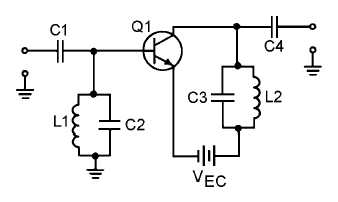2-20
R1
R2
RT
0
200
0.00
10
190
9.50
25
175
21.88
50
150
37.50
75
125
46.88
100
100
50.00
125
75
46.88
150
50
37.50
175
25
21.88
190
10
9.50
200
0
0.00
As you can see, this circuit has maximum resistance (RT) when the individual resistors are of equal
value. If the variable resistors represented impedances and if components could be found that varied their
impedance in the same way as the ganged resistors in figure 2-13, you would have the frequency-
determining network needed for an rf amplifier.
There are components that will vary their impedance (reactance) like the ganged resistors. As you
know, the reactance of an inductor and a capacitor vary as frequency changes. As frequency increases,
inductive reactance increases, and capacitive reactance decreases.
At some frequency, inductive and capacitive reactance will be equal. That frequency will depend
upon the value of the inductor and capacitor. If the inductor and capacitor are connected as a parallel LC
circuit, you will have the ideal frequency-determining network for an rf amplifier.
The parallel LC circuit used as a frequency-determining network is called a TUNED CIRCUIT. This
circuit is "tuned" to give the proper response at the desired frequency by selecting the proper values of
inductance and capacitance. A circuit using this principle is shown in figure 2-14 which shows an rf
amplifier with parallel LC circuits used as frequency-determining networks. This rf amplifier will only be
effective in amplifying the frequency determined by the parallel LC circuits.
Figure 2-14.—Simple rf amplifier.
In many electronic devices, such as radio or television receivers or radar systems, a particular
frequency must be selected from a band of frequencies. This could be done by using a separate rf
amplifier for each frequency and then turning on the appropriate rf amplifier. It would be more efficient if
a single rf amplifier could be "tuned" to the particular frequency as that frequency is needed. This is what

